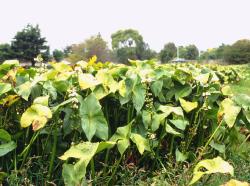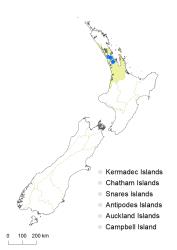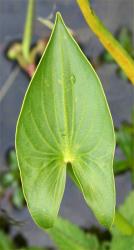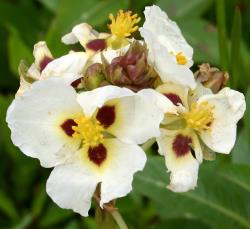Erect, perennial herb, from a short, thick rhizome to 2 m tall, corms and stolons absent. Emergent leaves sheathing, petiolate; lamina 200–340 mm long, 195–260 mm wide, sagittate to hastate, glabrous, large lobes with caudate to acuminate tips, apex caudate or acuminate, margin entire; petioles 200–550 mm long, 5.0–20 mm wide, semi-terete (D-shaped), septate, glabrous. Inflorescence a whorled raceme or panicle, bracteate, 280–620 mm long, 50–150 mm wide; 3–15 whorls of 3–5 pedicellate flowers; scape 730–1800 mm long, 6–15 mm wide, erect, terete, emergent. Staminate flowers about 30 mm diameter, sterile carpels absent, pedicels spreading to ascending 0.2–1.3 mm wide, terete; sepals 7.0–12 mm long, 4–6 mm wide, ovate, concavo-convex, with conspicuous membranous margins; petals white with a dark red spot at base, 10–25 mm long, 20–25 mm wide, broad-ovate with a narrow claw, delicate, apex rounded, irregularly crenate; stamens 12–many; filaments 3–4 mm long, dilated, glabrous; carpellate flowers about 20 mm diameter, carpels many, staminodes absent, pedicels spreading, becoming recurved in fruit, distinctly thicker than staminate pedicels, terete; sepals 12–19 mm long, 7–10 mm wide, appressed and enclosing fruiting head, petals white with a dark red spot at base, delicate, deciduous 17–18 mm long, 18–20 mm wide, broad-ovate with a narrow claw, apex rounded. Fruiting head 12–20 mm diameter. Achenes 1.5–3.0 mm long, 1.5–2.0 mm wide, obovate with a lateral beak, winged, brown. Seeds uncinate, brown.
Sagittaria montevidensis subsp. montevidensis has large, broad, arrow-shaped leaves and D-shaped petioles in T.S.; this and the white flowers with a conspicuous, dark-red petal spot distinguish it from other species of Sagittaria in New Zealand.
Sagittaria montevidensis subsp. calycina (not recorded in New Zealand) is distinguished by the absence of a coloured petal spot and shorter basal leaf-lobes (Haynes & Holm-Neilsen 1994).
Sagittaria montevidensis subsp. montevidensis is a designated unwanted organism in New Zealand under the Biosecurity Act, is banned from sale and distribution, and is targeted for eradication wherever it occurs.
North Island: Auckland – Dairy Flat, Auckland City, Manukau, Wairoa River, Clevedon, Waikato (Ohinemuri River, Paeroa).
Shallow ponds, river margins, riparian edges and mudflats.
AK 227092, G.D. Gregg, Manukau, north of Redoubt Road, motorway exit, 1996, cited in Ford & Gregg (1997).
Flowering: Nov.–Feb. Fruiting: Dec.–Mar.
2n = 20, 22 (Goldblatt & Johnson 2003).







